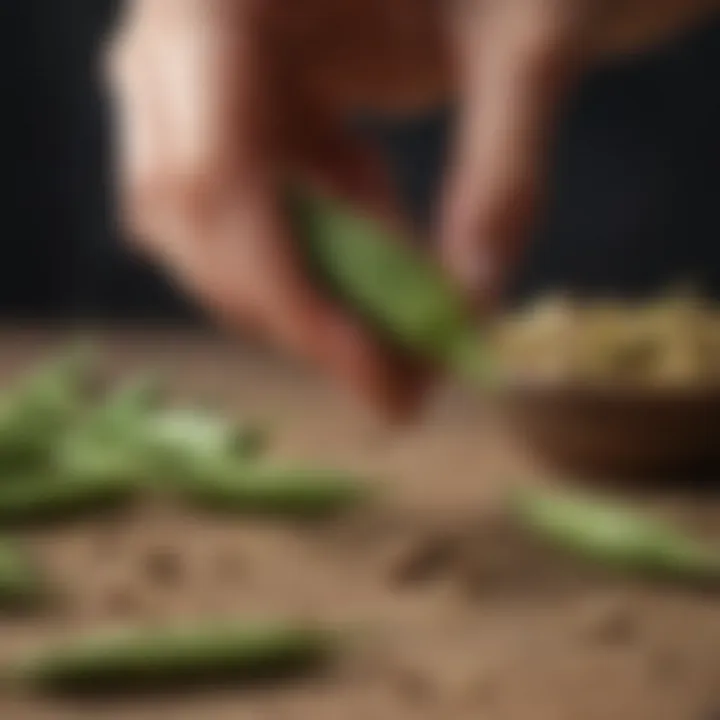Growing Okra from Seeds: A Comprehensive Guide


Intro
Growing okra from seeds is a task that requires careful consideration and an understanding of various factors affecting the cultivation process. As a valuable crop in many cuisines, okra provides both nutritional benefits and economic value. This guide aims to elucidate essential steps involved in cultivating okra, focusing on seed selection, germination, planting techniques, and the care required for healthy growth.
Overview of the Topic
Definition and Importance
Okra, scientifically known as Abelmoschus esculentus, is a warm-season vegetable known for its distinctive texture and flavor. Its importance goes beyond culinary appeal. The plant is rich in vitamins and minerals, making it a nutritious addition to many diets. Additionally, it thrives in various conditions, which makes it adaptable for different regions globally.
Current Trends
In recent years, there has been a growing interest in sustainable agriculture. Many farmers are turning to okra due to its relatively low resource requirements compared to other crops. With a focus on local food systems and sustainability, okra cultivation aligns well with current agricultural practices.
Key Techniques and Practices
Step-by-Step Guide
- Seed Selection: Choose high-quality seeds from reputable sources. Look for varieties known for their disease resistance and high yield potential.
- Germination: Soak the seeds in water for 24 hours to improve germination rates. This process helps to break the seed coat and starts the germination process.
- Soil Preparation: Okra prefers well-drained, fertile soil. Amend the soil with organic matter, such as compost, to provide essential nutrients.
- Planting: Seeds can be sown directly into the soil or started indoors. Ensure that the soil temperature is at least 70°F for optimal germination. Plant seeds about one inch deep and space them four to six inches apart.
- Watering: Water the plants regularly, especially during dry spells. Ensure the soil does not become waterlogged, as this can lead to root rot.
- Fertilization: Apply a balanced fertilizer during the growing season, following the recommendations based on a soil test.
- Pest and Disease Management: Monitor plants regularly for pests like aphids and diseases such as powdery mildew. Implement organic pesticides or additional cultural practices in response to any issues.
Tools and Equipment Needed
Some essential tools for growing okra include:
- Hand trowel
- Garden rake
- Hose or drip irrigation system
- Organic fertilizers
- Pest control products
Using the right tools increases efficiency and yields better results in cultivation.
Challenges and Solutions
Common Obstacles
Growing okra is not devoid of challenges. Common issues include:
- Pest infestations, particularly from aphids and beetles
- Diseases like root rot or powdery mildew
- Fluctuations in weather conditions affecting growth
Innovative Solutions
- Integrated Pest Management: Employ strategies such as introducing beneficial insects to control pest populations naturally.
- Crop Rotation: Rotate crops annually to prevent the buildup of soil-borne diseases.
- Diverse Planting: Mix okra with other complementary crops to help deter pests.
"Understanding the specific needs of okra plants leads to a higher probability of a successful harvest."
By adopting these practices, farmers can overcome obstacles and cultivate okra effectively. It is essential to remain vigilant and responsive to the changing conditions throughout the growing season.
Prolusion to Okra
Okra, scientifically known as Abelmoschus esculentus, is a unique vegetable that holds significance in various cuisines and agricultural practices. Understanding okra is vital for those involved in farming and gardening. This section aims to present a thorough overview of okra, exploring its characteristics, value, and relevance in sustainable agriculture practices. The adaptations and requirements of this crop will be discussed, emphasizing its importance as a staple in warm climates and its role in crop rotation.
Overview of Okra as a Crop
Okra is predominantly cultivated in tropical and subtropical regions, making it an adaptable choice for diverse environments. It thrives in warm weather, requiring full sunlight for optimal growth. As a crop, okra is not only valued for its culinary uses, but also for its hardiness and resistance to certain pests and diseases. Its growth cycle from seed to harvest can span roughly 60 to 90 days.
Key aspects of okra as a crop include:
- Diversity: There are several varieties of okra, each with distinct characteristics, ranging from size to color. For example, green okra is commonly found in markets, while red okra adds an interesting touch to gardens and dishes.
- Economic Importance: Okra is a valuable cash crop in countries like India, Nigeria, and the United States, contributing to local economies and food security.
Nutritional Value and Uses
The nutritional profile of okra is noteworthy. It is low in calories yet rich in vitamins and minerals, making it a healthy choice for many diets. Here are some nutritional highlights of okra:
- Vitamins: Okra is rich in vitamins A, C, and K, which are essential for maintaining various bodily functions.
- Fiber: The high fiber content aids digestion and contributes to heart health.
- Antioxidants: Chock-full of antioxidants, okra can help combat oxidative stress in the body.
In culinary contexts, okra is quite versatile. It can be used in stews, soups, and even fried for a crunchy snack. Its unique texture and flavor contribute to various traditional dishes, especially in Southern cuisine and Middle Eastern recipes. Overall, understanding the nutritional value and culinary uses of okra enhances its appeal as both a crop and a food source.
Choosing the Right Okra Seeds
Selecting the appropriate okra seeds is fundamental for both novice and seasoned growers. The variety of seeds impacts growth rate, yield, and resilience against pests and diseases. Understanding the options available can make the difference between a fruitful harvest and a disappointing outcome. Factors to consider include not only the types of okra but also their adaptability to specific growing conditions, which is essential for achieving a successful cultivation process.
Varietal Differences and Characteristics
Okra cultivars can vary significantly in attributes such as color, size, and flavor. These differences play an important role in how the plants will perform under varying environmental conditions.
Green vs. Red Okra
Green okra is the more common variety found in markets and gardens. Its key characteristics include tender texture and a mildly sweet flavor. This type is often preferred because it is well-established in many cooking traditions, making it widely accepted. On the other hand, red okra, like the , offers a unique advantage in terms of its striking color and visual appeal. The visual aspect can attract consumers looking for novelty or gourmet ingredients. However, red okra tends to have a slightly tougher skin compared to its green counterpart.
Choosing between green and red okra can significantly influence consumer interest and marketability.
Unique Features: Red okra’s impressive color is appealing but can sometimes lead to a lower yield. It may also require more attention to detail regarding nutrient requirements. In contrast, green okra is resilient and thrives in a wider range of conditions, making it a safer option for general cultivation.


Disease Resistance
Disease resistance is crucial for sustaining healthy plants and ensuring a productive harvest. Selecting seeds with high disease resistance can reduce the need for chemical interventions, supporting environmentally friendly practices. Key characteristics of disease-resistant okra varieties include improved growth vigor and higher survival rates in adverse conditions. Such traits are advantageous in regions where certain diseases are prevalent, allowing farmers to mitigate risks effectively.
Unique Feature: Disease-resistant okra varieties can lead to less crop loss due to infections, thereby improving overall yields. However, these seeds might be slightly more expensive than standard options, urging growers to assess their budget versus long-term benefits.
Source and Quality of Seeds
Obtaining high-quality seeds is critical in the process of growing okra successfully. The source of your seeds can heavily influence their viability and performance. Seeds from reputable suppliers generally offer better germination rates and disease resistance, which are essential for a robust crop.
When selecting seeds, always pay attention to the packaging, ensuring that it includes clear information about the seed's age and storage conditions. This knowledge aids in determining the potential success of germination and growth.
Moreover, consider the reputation and reviews of the seed suppliers. Choosing well-reviewed sources can greatly enhance the likelihood of seed quality. Researching community feedback or agricultural forums can provide insights into which sources have the best track records in delivering quality seeds, ensuring you start with the best chance for success.
Preparing for Planting
Preparing for planting is a crucial phase in the cultivation of okra. This step ensures that the environment is suitable for the growth of the plants, giving them the best chance to thrive. A well-prepared site can directly impact the vigor and productivity of the crop.
Site Selection and Soil Requirements
The choice of site and soil can determine the success of your okra venture.
Sunlight Needs
Sunlight is essential for okra plants. Ideally, they need full sun, which means at least six to eight hours of direct sunlight each day. Sunlight contributes to photosynthesis, the process by which plants convert sunlight into energy. Without adequate sunlight, okra may become leggy and produce fewer pods.
A benefit of full sun exposure is that it helps to control moisture levels in the soil, as well. Drying out the surface can prevent fungal diseases. However, during extreme heat conditions, some shade may be beneficial to prevent stress on the plants. Careful site selection can mitigate these risks.
Soil pH and Drainage
Soil pH and drainage are two critical aspects that influence okra growth. The recommended pH for okra is between 6.0 and 6.8. This range allows for optimal nutrient uptake. Testing the soil pH before planting helps in amending soil for ideal growing conditions.
Moreover, okra requires well-draining soil. Poor drainage can lead to root rot and other diseases. A unique advantage of well-drained soil is that it promotes healthy root development. However, there can be challenges if the soil is too sandy, as it may not retain enough moisture. Thus, a balanced approach is essential.
Soil Preparation Techniques
Soil preparation is necessary to create an optimal environment for okra.
Tilling and Fertilization
Tilling is an essential practice before planting. It involves turning the soil to aerate it and incorporate organic matter. This process also improves soil structure and promotes microbial activity, which is beneficial for plant health. Fertilization adds necessary nutrients, particularly nitrogen, phosphorus, and potassium. These nutrients support foliage growth and pod development.
The drawback is that excessive tilling can lead to soil compaction. Using organic fertilizers can mitigate this risk while enhancing soil fertility. Careful application rates are needed to prevent nutrient runoff.
Weed Management
Effective weed management is vital. Weeds compete with okra for resources like water and nutrients. They can hinder growth and yield. Implementing pre-emergent herbicides can prevent weed establishment. Additionally, row covers and mulching can suppress weed growth while preserving soil moisture.
The downside is that while some herbicides are effective, they can harm beneficial insects and soil microorganisms. Manual removal of weeds is labor-intensive but environmentally friendly. Balancing both techniques is key to maintaining a healthy growing environment.
Proper preparation before planting not only enhances growth but significantly contributes to the overall health of the okra plants.
Germination of Okra Seeds
The germination process of okra seeds is a crucial step in the cultivation journey. Proper germination not only influences successful seedling establishment but also affects overall plant health and yield. Understanding the requirements for germination can enhance productivity and success rates for both seasoned farmers and enthusiasts.
Optimal Germination Conditions
Temperature Requirements
Temperature is pivotal for the germination of okra seeds. Ideally, seeds should germinate at temperatures between 75°F to 90°F (24°C to 32°C). This range supports efficient metabolic processes necessary for seed sprouting. A key characteristic of these temperatures is their ability to activate enzyme systems within the seed, leading to optimal growth.
Maintaining a stable temperature in this range is highly beneficial. If temperatures dip below 70°F (21°C), germination can be significantly delayed or even inhibited. On the other hand, temperatures exceeding 95°F (35°C) may lead to poor germination rates or weak seedlings. The unique feature of temperature requirements in this context is the direct impact it has on germination speed and seedling vigor.
In summary, the right temperature is essential for a high germination rate, improving the chances of a strong okra crop.
Moisture Levels
Moisture levels also play a vital role in seed germination. Okra seeds require consistent moisture to initiate the germination process. Keeping soil consistently moist, but not waterlogged, is key to successful seedling development. A critical aspect of moisture is its ability to facilitate the absorption of nutrients and oxygen, which are necessary for seed activation.
The ideal moisture level creates a conducive environment for the seeds to swell and begin the germination process. However, it is essential to avoid oversaturating the soil, as excessive moisture can lead to seed rot and fungal diseases. A unique feature of maintaining proper moisture levels is the delicate balance between hydration and aeration. Too little moisture can halt the germination process entirely, while too much can suffocate the developing roots.
Germination Process
The germination process of okra seeds involves several stages that must be carefully monitored. Once the seeds absorb adequate moisture, they begin to swell. This swelling indicates that the seed is active and ready for germination.
After swelling, the seed coat breaks, and the embryonic root, known as the radicle, emerges first. This root anchors the seedling into the soil, securing it as it grows. Subsequently, the shoot emerges, which will develop into the plant's stem and leaves.


It is essential to provide adequate light, warmth, and moisture during these initial growth phases. Seeds may take anywhere from five to twelve days to germinate, depending on environmental conditions. Timely monitoring of soil moisture and temperature can promote a smooth and successful germination process.
Managing these conditions effectively ensures that the seedlings are strong and establish a healthy foundation for their growth.
Planting Okra Seeds
Planting okra seeds is a crucial step in the cultivation process. The way in which seeds are planted can significantly affect their growth and overall yield. Understanding proper planting techniques will help ensure robust plants that produce well. There are several vital considerations to take into account when planting okra seeds, such as seed spacing, depth, and the choice between transplanting or direct seeding.
Seed Spacing and Depth
When planting okra seeds, it is essential to determine the correct spacing and depth. Seed spacing is important because it affects air circulation and sunlight exposure, vital for plant health. Typically, okra seeds should be planted about 12 to 18 inches apart. This distance allows each plant enough room to grow without competing for resources.
The depth at which seeds are sown also plays a significant role. Generally, okra seeds should be planted 1 to 2 inches deep in the soil. If the seeds are planted too shallow, they may dry out quickly. Conversely, planting them too deep can hinder germination. The soil should be well-prepared before planting to achieve the right conditions for the seeds to thrive.
Transplanting vs. Direct Seeding
Farmers and enthusiasts often face the decision between transplanting seedlings or opting for direct seeding. Each method has its unique benefits and considerations.
Transplanting can provide several advantages. Starting seeds indoors allows for an earlier growing season. It also grants better control over the seedling environment, which can lead to stronger plants. However, transplanting requires careful handling to avoid damaging the delicate roots during the transfer.
Direct seeding, on the other hand, is simpler and can be less labor-intensive. It reduces the risk of transplant shock since the plants grow directly in their final location. Nevertheless, this method depends heavily on ideal soil temperature and moisture conditions, as direct seeding in unfavorable conditions can lead to poor germination rates.
Both methods can be successful if implemented correctly, but understanding your local climate and soil conditions will help in making the best choice.
Understanding how to effectively plant okra seeds can lead to a healthier and more productive crop.
Ultimately, proper planting techniques are vital for successful okra cultivation. Focus on proper seed spacing and depth, and carefully consider whether to transplant or seed directly. These choices will have lasting impacts on the growth and productivity of your okra plants.
Caring for Okra Plants
Caring for okra plants is a vital aspect of successful cultivation. This segment ensures that the plants thrive throughout their growing period. Continuous attention to their needs leads to healthier plants and a more abundant harvest. The care regimen encapsulates watering and fertilization practices that significantly influence plant growth, strength, and yield. Careful monitoring of these elements allows for timely interventions, ensuring that the okra plants are well-supported as they mature.
Watering Practices
Watering is fundamental in the life of okra plants. Proper moisture levels need to be maintained to enhance growth. Okra plants prefer consistent moisture, particularly in the early stages after germination. It is important to water them deeply rather than frequently. This approach encourages deep root development, which is essential for the plant’s stability.
Factors to consider in watering include:
- Soil Type: Sandy soils may require more frequent watering than clay soils, which retain moisture for longer durations.
- Weather Conditions: During hot and dry conditions, increase watering to prevent stress on the plants.
- Plant Age: Young plants have different moisture needs compared to fully established ones.
Watering in the morning is preferable. This practice reduces evaporation and ensures that the plants absorb moisture effectively throughout the day. Over-watering should also be avoided as it can lead to root rot and other diseases.
Fertilization Routine
Fertilization plays a crucial role in nurturing okra plants. A well-planned fertilization routine provides necessary nutrients that support growth and fruiting. Before planting, incorporating organic matter into the soil can enhance fertility. Compost or well-rotted manure are excellent options, contributing both nutrients and improving soil structure.
Once the plants are established, a balanced fertilizer with equal parts nitrogen, phosphorus, and potassium can be beneficial. Here is what to keep in mind:
- Nitrogen is critical for foliar growth, ensuring the leaves are robust and capable of photosynthesis.
- Phosphorus supports root development and encourages flowering, which is vital for fruiting.
- Potassium strengthens the overall health of the plant and increases resistance to diseases.
A couple of applications, typically in early stages of growth and then during flowering, can be ideal. It is essential to follow product instructions regarding dosage and timing. Soil testing before planting can provide insight into existing nutrient levels and help tailor the fertilization plan.
"High-quality care during the growing season can lead to higher yields and healthier plants, making it vital for any serious okra grower."
In summary, proper care of okra plants through attentive watering and a well-structured fertilization routine is essential for achieving optimal growth and yield. Monitoring these factors will lead to successful harvests and ensure that you get the most out of your okra cultivation.
Pest and Disease Management
Effective management of pests and diseases is paramount for successful okra cultivation. As with any crop, okra is susceptible to various threats that can compromise its growth and yield. Understanding these challenges allows farmers and enthusiasts to devise strategies that enhance resilience and productivity. The following subsections will delve into common pests that affect okra and outline preventive measures and treatments to mitigate these issues.
Common Pests Affecting Okra
Okra is particularly vulnerable to several common pests, including:
- Aphids: These tiny, sap-sucking insects can quickly multiply and weaken plants. Their feeding leads to stunted growth and leaf curling.
- Flea Beetles: Small and jumping, these beetles cause significant damage by creating small holes in leaves, impacting photosynthesis.
- Spider Mites: These arachnids thrive in hot, dry conditions and cause yellowing of the leaves, often leading to a decline in overall plant health.
- Cutworms: They are soil-dwelling caterpillars that cut seedlings at the base, often unnoticed until it’s too late.
- Whiteflies: These small, white-winged insects also suck sap from leaves, which can lead to weakening of the plant and foster disease spread.
Understanding the life cycles and behaviors of these pests is essential for effective control. Monitoring plants regularly can help in early detection, enabling timely interventions that minimize damage.
Preventive Measures and Treatments
Preventive strategies and treatment options are critical in managing pest and disease challenges in okra. Here are some effective methods:
- Crop Rotation: Rotating crops can disrupt pest life cycles, reducing their populations in the soil.
- Companion Planting: Certain plants, such as marigolds, can repel pests like aphids and nematodes, providing a natural shield for okra.
- Pest Barriers: Floating row covers can be effective during the early growing season, preventing pests from accessing young plants.
- Natural Predators: Attracting or introducing beneficial insects, like ladybugs and lacewings, can help control aphid populations naturally.
- Neem Oil: This natural pesticide disrupts the lifecycle of many pests and is useful against aphids and spider mites. It is a safer alternative to synthetic chemicals.
- Insecticidal Soap: A mixture of soap and water can effectively manage soft-bodied insects like aphids and whiteflies without harming beneficial insects when applied properly.
Remember: The key to effective pest management is an integrated approach that combines multiple strategies for best results.
By understanding the importance of pest and disease control, okra growers can ensure healthier plants and a more bountiful harvest. Staying vigilant and using the right strategies can make a significant difference in the success of an okra farming endeavor.


Harvesting Okra
Harvesting okra is a critical phase in the cultivation process. This stage determines the quality of the produce and affects overall yields. Understanding the right time to harvest ensures that the okra remains tender and flavorful, maximizing both its marketability and culinary uses. The timing of the harvest can significantly influence the plant's productivity in the following cycles, as well. For optimal harvesting, certain indicators must be closely monitored and effective techniques applied.
Indicators of Ripeness
To successfully harvest okra, it is essential to recognize its signs of ripeness. The pods should ideally be harvested when they are young and tender. Typically, okra is ready for harvest when the pods are about three to four inches long. If left too long on the plant, the pods can become fibrous and tough, making them less desirable for consumption. Key indicators of ripeness include:
- Size: Pods should be of proper size, usually harvesting at three to four inches.
- Color: The color often appears vibrant green, or darker in case of red varieties.
- Texture: The pods should feel firm but not hard; a slight give indicates the correct stage.
- Time of Day: Early morning is often the best time to harvest as cooler temperatures minimize moisture loss.
"Harvesting at the right moment ensures you enjoy the best taste and consistency of okra."
Harvesting Techniques
The technique used for harvesting okra can significantly impact the efficiency and speed of the process. Hand-picking is the favored method, as it allows for careful selection without damaging the plant or surrounding pods. Here are some effective techniques:
- Use of Gloves: Wearing gloves can protect from the plant's prickly surfaces during harvesting.
- Cutting with Shears: Sharp garden shears or scissors can be used to cut the pods from the plant, ensuring minimal disturbance. This method is beneficial for preserving the plant for future harvests.
- Twisting and Pulling: Some farmers prefer to twist the pods gently and pull them from the stem. This method works well with tender pods but requires caution to avoid breaking the stem.
- Regular Harvests: Frequent harvesting, about every two to three days, encourages the plant to produce more pods.
These techniques ensure a clean harvest while promoting continuous growth and yield from the okra plants. Proper attention to detail during this stage not only maximizes the quality of the okra but also supports the sustainability of future harvests.
Post-Harvest Practices
After harvesting okra, the attention shifts to post-harvest practices to maintain quality and extend shelf life. These processes are crucial to prevent spoilage and maximize the value derived from the crop. By implementing effective post-harvest methods, farmers can ensure that their efforts in growing and harvesting do not go to waste. Proper techniques can also contribute to greater marketability and consumer satisfaction.
Cleaning and Storing Okra
Cleaning okra post-harvest is a key step that prepares it for storage or sale. It is advisable to handle the pods gently to avoid bruising. Start by rinsing the okra under cool water, making sure to remove any dirt or debris. After that, it is helpful to dry the okra using a clean towel or allowing it to air dry. This step is essential as excess moisture can contribute to mold growth during storage.
Storage conditions play a significant role in maintaining the freshness of okra. The ideal method is to place the cleaned pods in perforated plastic bags. These bags help maintain humidity while allowing for air circulation. Storing okra in the refrigerator at a temperature of around 45-50°F can prolong its shelf life, often retaining quality for up to a week.
Important: Avoid washing okra until right before use to limit moisture retention.
Culinary Uses and Nutritional Benefits
Okra is not just valued for its agricultural merit; it is also a versatile ingredient in culinary applications. Its unique texture and flavor open up numerous possibilities in various recipes. From traditional gumbo to pickling, the uses of okra are diverse.
Nutritionally, okra offers many benefits. It is low in calories but rich in essential nutrients such as vitamins C and K, as well as dietary fiber. This makes it a great addition to a balanced diet. Fiber helps with digestion and can aid in maintaining a healthy weight.
Moreover, the antioxidant properties of okra contribute to overall health. Incorporating okra into meals can provide a pleasant texture in dishes, enhancing both flavor and nutritional content. Some common culinary uses include:
- Sautéing or frying
- Adding to soups and stews
- Utilizing in salads
The combination of its nutritional benefits and culinary versatility ensures that okra remains a popular choice for many households.
Sustainability in Okra Farming
Sustainability in okra farming is an essential aspect due to its wide-ranging impacts on both the environment and agricultural productivity. As farmers and enthusiasts seek to maximize yield and efficiency, incorporating sustainable practices ensures that okra farming can be viable for future generations. Several crucial elements contribute to the sustainable cultivation of okra, including resource management, biodiversity, and environmental preservation. By adopting a holistic approach, farmers can minimize the negative effects of agriculture on the ecosystem while enhancing productivity and resilience.
Eco-Friendly Practices
Implementing eco-friendly practices is central to sustainable okra farming. These methods help in reducing chemical inputs, conserving water, and promoting biodiversity. Here are some effective eco-friendly practices for okra cultivation:
- Crop Rotation: Rotating okra with other crops helps prevent soil nutrient depletion and minimizes pest populations.
- Organic Fertilizers: Using compost or green manure can improve soil fertility without the adverse effects of synthetic fertilizers.
- Integrated Pest Management (IPM): IPM strategies focus on using natural predators, traps, and biopesticides to combat pests instead of relying solely on chemical pesticides.
- Mulching: Applying organic mulch can reduce soil erosion, maintain moisture, and suppress weeds, leading to fewer resource inputs.
- Cover Cropping: Planting cover crops during the off-season can enhance soil structure, reduce erosion, and increase organic matter.
By embracing these eco-friendly practices, farmers not only contribute to a healthier ecosystem but also often find improvements in the quality and yield of their crops.
Contributions to Soil Health
Soil health is fundamental to successful agriculture, and the cultivation of okra offers unique opportunities to enhance it. Sustainable okra farming contributes to soil health in various ways:
- Soil Structure Improvement: Practices such as tilling minimally or adopting no-till farming can help maintain soil structure, reduce compaction, and promote root growth.
- Nutrient Cycling: The rotation of okra with legumes can facilitate natural nitrogen fixation, enriching the soil with essential nutrients.
- Microbial Activity: Healthier soils support a diverse microbial population, which aids in nutrient degradation and uptake, ensuring that plants, including okra, thrive.
- Erosion Control: Sustainable practices reduce soil erosion by maintaining vegetation cover and enhancing the resilience of the soil against wind and water.
By prioritizing soil health through sustainable practices, farmers not only ensure a productive okra crop but also contribute to long-term agricultural sustainability. This reflects a commitment to preserving natural resources while still achieving high-quality yields.
"Sustainable practices in farming are not just beneficial for the environment; they are crucial for the long-term viability of agriculture itself."
Ending
In any guide about growing crops, the conclusion serves a vital role. It encapsulates the journey through the various stages of okra cultivation, linking theory with practice. Recapping the essential points reinforces understanding and retention for readers, ensuring that the information presented is actionable. This section also highlights the challenges and satisfactions that come from nurturing a plant from seed to harvest.
Sustainability also emerges as a key theme. Recognizing the eco-friendly practices discussed not only aids the environment but also contributes to the long-term success of farming endeavors. Every farmer or enthusiast needs to consider how farming choices affect broader ecosystems.
Finally, this conclusion emphasizes that the cultivation of okra is not a solitary effort. It benefits from community, collaboration, and continued learning. Engaging with resources and networks ensures that growers can share insights and best practices, leading to richer harvests and more rewarding experiences.
Recap of Key Points
- Seed Selection: Choosing the right okra variety impacts growth and yield.
- Germination: Optimal conditions are crucial for early growth.
- Planting Techniques: Understanding soil depth and spacing can prevent overcrowding and promote healthy development.
- Care and Maintenance: Regular watering and fertilizing are essentials that need to be tailored to specific growing conditions.
- Pest Management: Early detection and intervention are key to maintaining plant health.
- Harvesting: Recognizing ripeness is necessary for optimal flavor and texture.
- Sustainability Practices: Methods like crop rotation and organic pest control foster soil health and yield longevity.
Future Prospects for Okra Cultivation
The future of okra cultivation appears promising. Advancements in agricultural technology, such as precision farming and genetic research, continue to enhance the potential for improved varieties that resist disease and yield better crops. Also, as global diets evolve, the demand for diverse crops like okra grows.
Moreover, urban farming and greenhouse technologies offer new avenues for city dwellers to participate in growing okra. This not only makes fresh produce more accessible but also encourages sustainable practices in urban environments. Increased interest in plant-based diets also suggests a market rise for okra, urging farmers to adapt by employing smart and effective strategies.
In summary, as interest in sustainable and nutritious crops expands, keeping abreast of trends and innovations will be beneficial. Continuous education and collaboration among farmers, researchers, and enthusiasts will foster a vigorous community dedicated to cultivating this versatile crop effectively.



